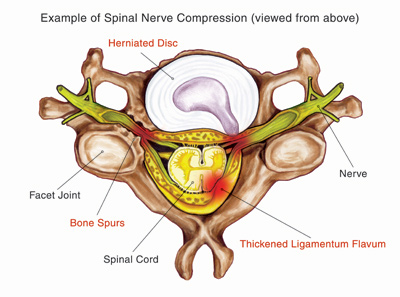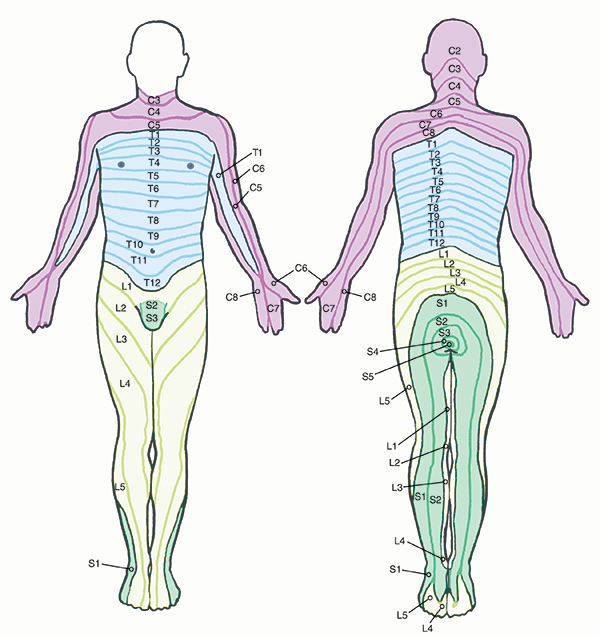A lumbar epidural injection is a safe and effective minimally invasive treatment for the treatment of certain types of low back pain. This type of spinal injection services two purposes: (1) reduces nerve inflammation, calms symptoms, aids healing and, (2) provides the physician with important diagnostic information.
The procedure involves injecting a corticosteroid into the epidural space. A corticosteroid is a powerful, slow-releasing, and long-lasting anti-inflammatory medication effective in reducing inflammation. Sometimes a narcotic is also injected to increase pain relief. The epidural space is between the protective membrane (dura mater) covering the spinal cord and the bony spinal canal. After the medication is injected, it flows and coats the nerve roots.
Diagnostically, when the patient’s symptoms are relieved, the injection provides evidence that a particular nerve root is a pain generator.
There are many spinal problems that can cause low back and leg pain (sciatica). As depicted in the illustration, a herniated disc or bone spurs (osteophytes) can compress fragile spinal nerve roots.

Basics about Lumbar Spinal Nerves
In the lumbar spine there is 5 pair of spinal nerves. Each pair of nerves provides sensation and function to specific parts of the body. Just as the levels of the lumbar spine are abbreviated, the spinal nerve pairs are numbered in a corresponding way. The L1 nerve roots exit the left and right sides between the first and second lumbar vertebrae (L1-L2). L5 exits between the last lumbar vertebra and the sacrum (L5-S1).

Each pair of nerve roots exit the spinal column and branch out into the body forming the peripheral (outer) nervous system. These nerves innervate the lower part (below the waist) of the body and enable movement (motor function) and feeling (sensory function). The illustration depicts this pattern called dermatomes. Physicians use the dermatomal pattern to help diagnose the location of certain spinal problems based on where the patient reports having pain or weakness.
Based on the reported symptoms, medical history, physical and neurological examination, and imaging study findings (X-ray, MRI), the physician may be able to determines which spinal nerve root(s) are associated with the pain and other symptoms.
Patient Procedure Preparation
Before the procedure, the patient is typically interviewed about the medications he or she takes and is given specific instructions. Some types of medications may have to be stopped several days before the procedure. In some cases, prospective patients are also asked to stop taking pain medication and anti-inflammatory agents before the procedure in order to see how much relief is derived specifically from the injection.
Possible Risks and Complications
Any medical procedure poses a risk or possible complication. Although extremely rare, possible risks or complications include bleeding, infection, nerve injury, and allergic reaction to medication. Other complications include a possible increase in pain, injection site tenderness, and steroid side effects. The physician will discuss the risks and benefits of a lumbar epidural injection with the patient.
What to Expect: The Procedure and After
The environment and preparation for lumbar injection is similar to outpatient surgery. The patient checks into the facility, may be asked to complete some paperwork, and then changes into a hospital gown and lies on a hospital bed. An intravenous line is placed so that the patient can receive medications to during the procedure to help him or her relax. The patient is awake during the epidural injection and may be asked questions about pain during the procedure.
The patient is positioned such that the physician has good access to the lower back. This involves lying face down with a cushion under the abdomen to keep the spine flexed and the patient comfortable. Next, the skin area is cleaned with a sterile soap. A local anesthetic is injected to number the injection site area.
A fluoroscope, which is a type of video X-ray, is positioned over the patient. This is a large piece of equipment called the C-arm, named for its characteristic C-shape. The fluoroscope projects images on monitors in the room to show the physician and others in the room exactly what is going on. Using fluoroscopy, the physician places the needle and injects a small amount of contrast (dye) to make sure the needle is in proper position. Next, an anesthetic and corticosteroid is injected into the epidural space. Sometimes, pain is temporarily increased during the injection. The physician may ask the patient for feedback during the procedure and will make the patient as comfortable as possible. When the injection is over, the injection site is covered with a small bandage.
A lumbar epidural injection treatment may involve one or several injections. The entire procedure takes around 15 minutes. When it is over, the patient is brought to a recovery area where a nurse monitors him or her. When the patient can be discharged (usually in a short period of time), the nurse provides written instructions regarding home care.
Some patients experience discomfort after the procedure for two or three days. This is normal and does not necessarily mean the corticosteroid is not taking effect. Typically, the physician’s office will call the next day to follow up. Some physicians recommend that patients keep a daily record of pain levels and symptoms following a lumbar injection to provide the medical team with information that could guide further treatment.
Conclusion
Lumbar spinal injections have provided significant pain relief to many people with moderate to severe low back pain. Not everyone is an appropriate candidate for this procedure, and prospective patients should discuss risks and benefits with their physicians.
